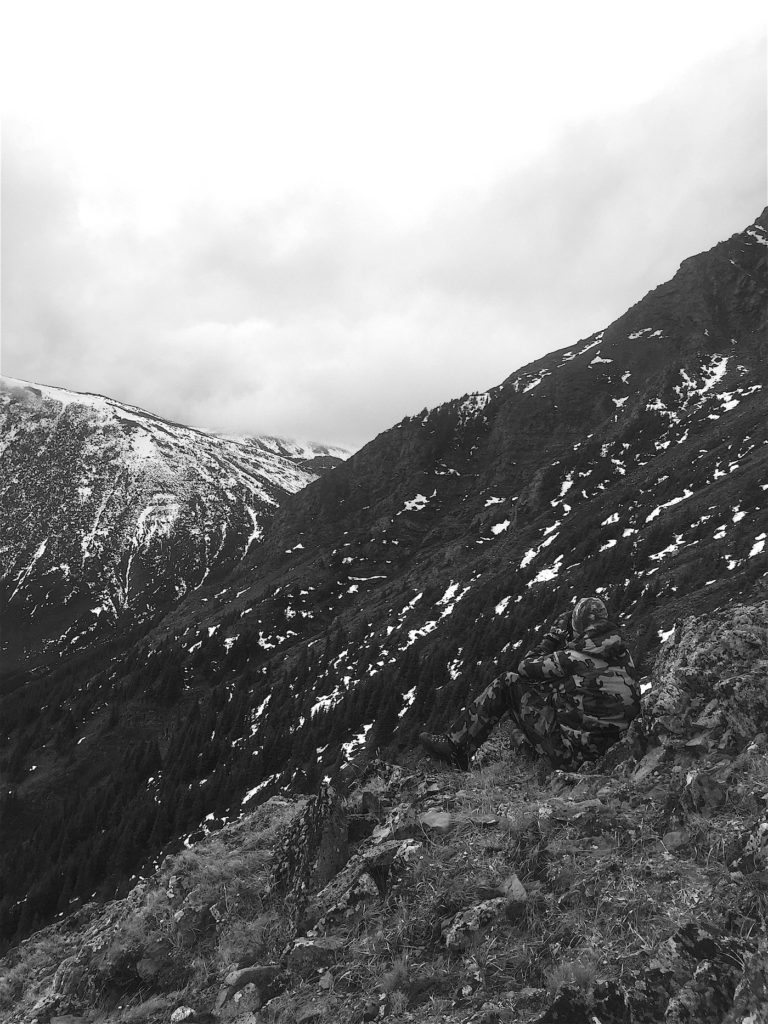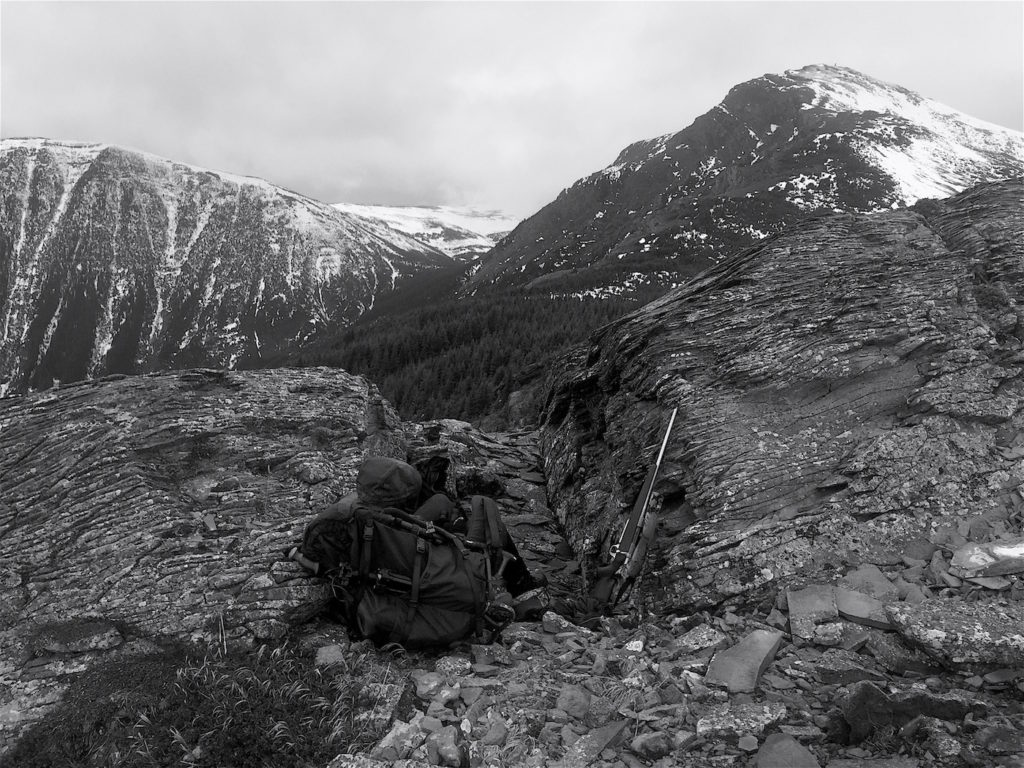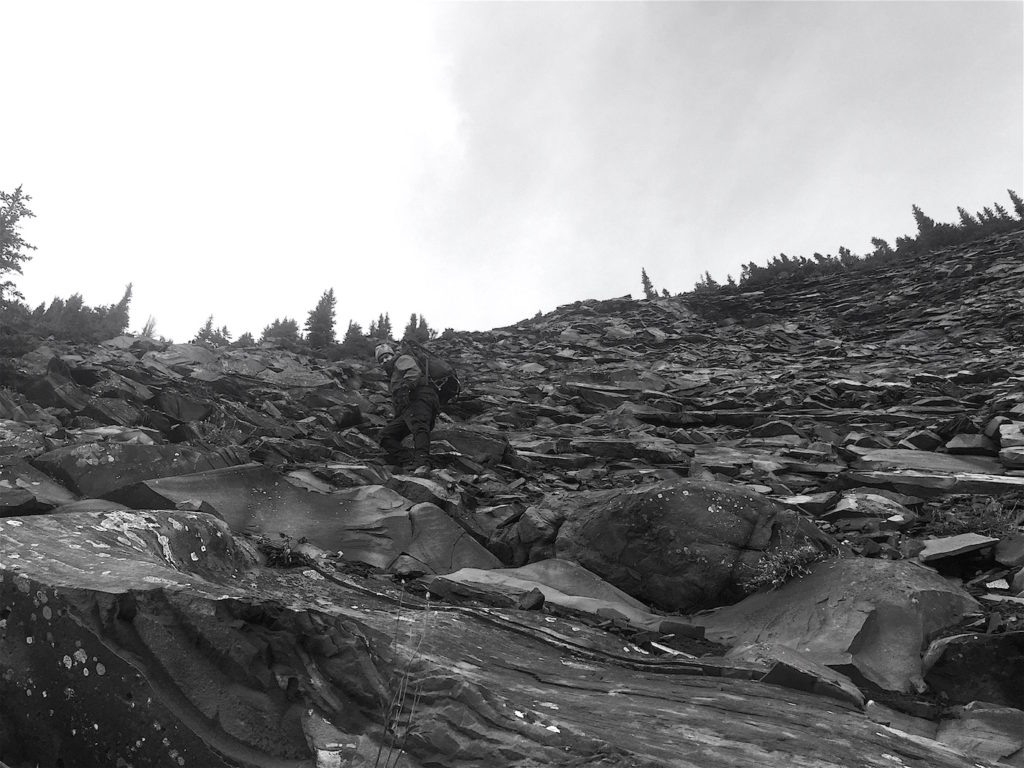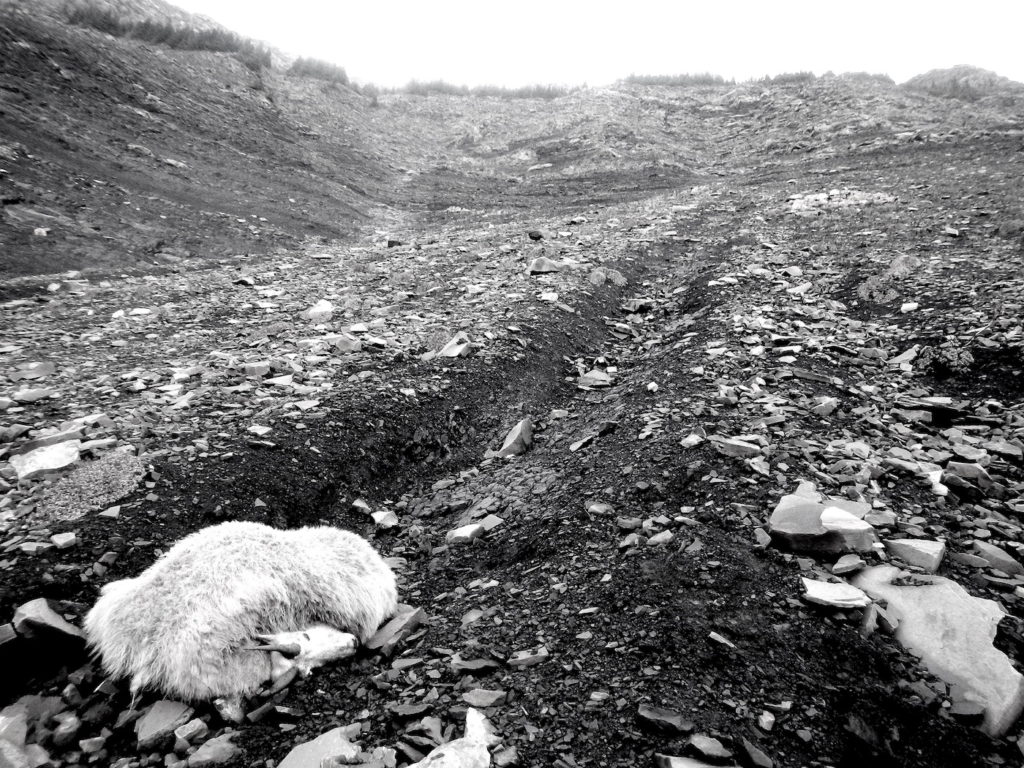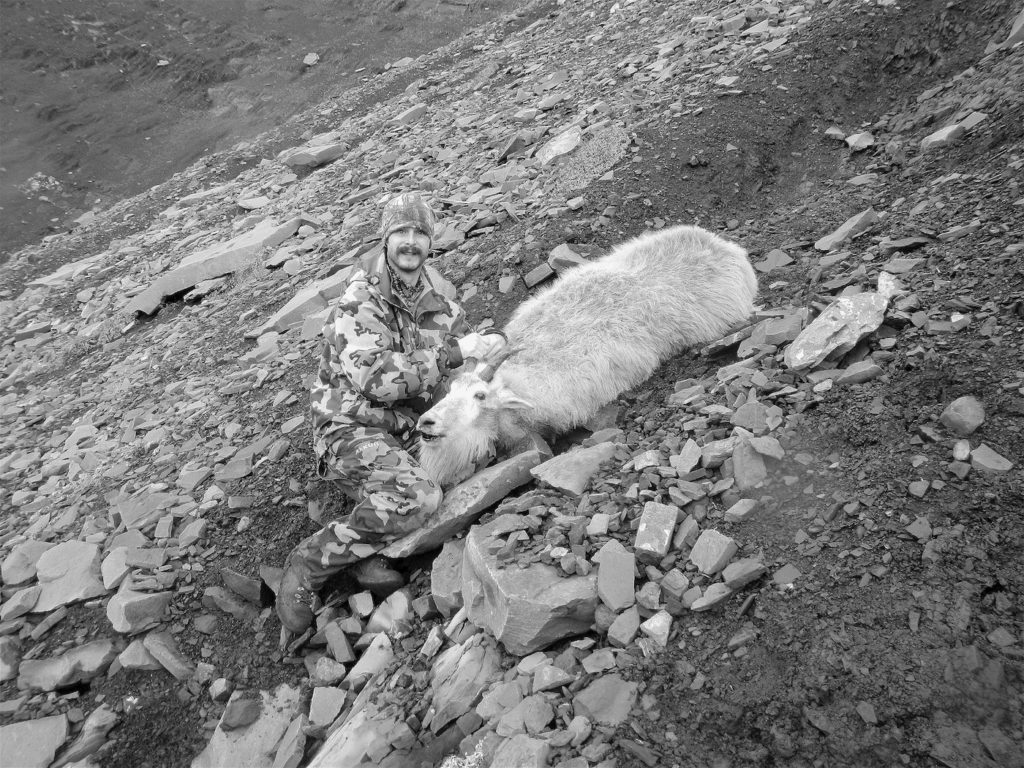The alarm went off at four in the morning, and I eagerly jumped out of bed. It was time for my long-awaited goat hunt. I had drawn a Limited Entry Hunting (LEH) tag in a prime goat area and the season ended November 15 – only a few days away, and time was running out. Recently my life had drastically changed for the better. My wife and I welcomed our first child early that spring and I was busy being a new parent. There are only so many hours in a day and days in a month, so between my family and work something had to go – hunting was that something. But this year, I had a tag and I wanted a goat. The stars aligned and there came a day when both my hunting partner Robin and I managed to sneak away with the blessings of our wives. One of the lures of this particular goat area is that it is only 2.5 hours from my house, and access is fairly easy (it has a major road not too far from the trailhead leading into the mountains).
I had drawn this tag a few years previous and had spent a few weekends hunting and getting the lay of the land. I had spotted several groups of nannies and kids on that hunt and on the last day, I finally found several billies, all within one basin. My wife and I made a stalk on a nice billy, but got cliffed out before we could get within shooting distance. We left that day without a goat, but the information gained left me with a firm game plan for next time.
This past year brought an unusually warm November – usually, we see freezing temperatures and a lot of snow. When Robin arrived at my house at 5:00 a.m., it was overcast and raining. I wasn’t sure what the weather conditions would be like up high in the mountains and if they would be a hindrance or helpful to our hunting expedition. To make sure I was prepared for anything, I had packed my gear the night before: everything from rain gear to snowshoes. Traveling by truck and ATV before hiking gave us the luxury of bringing the whole toolbox and not being limited by weight.
Before we left the house, I compiled an emergency response plan with my wife – telling her our location, and what time to expect a check-in call. Because we only had one day to hunt, I was able to pinpoint exactly where we would go; the goats would be there or they wouldn’t. This time of year it’s dark by 5:30 p.m., so I figured 8:00 would give us ample time to get off the mountain and back to an area with cell coverage to check in. We were only going for the day, so I decided to leave my InReach at home as I didn’t get around to taking it off standby mode and activating it; and anyway, why would I need it?
As we drove towards the mountains, the steady drizzle continued and the temperature hovered just above freezing. I was optimistic that the weather would clear like the forecast predicted, but with our limited time frame we were committed either way. We arrived at the end of the trail just as daylight was breaking. My first glimpse of the mountains wasn’t very encouraging: visibility was poor and clouds hovered a couple hundred feet above tree line. Here and there the mountain poked through the white mist, tempting us with the hidden secrets behind her veil. We unloaded the ATV and continued another few kilometers to the end of the logging road near the base of the mountain. From the end of the quad trail – the spot I had previously spotted the billy – we still couldn’t see much of the mountain. Without the clouds we should have been able to glass the entire basin, but in our situation we would be hiking up the mountain on blind faith alone. From previous mountain hunting experience, I knew a lot of sweat and energy can be lost hiking blind and I’d rather let my binoculars do the walking. But we were running out of options, so we decided to go for it and hope for the best.
We got our gear organized, made sure we were not leaving anything important behind, shouldered our packs, and started up the mountain. On my previous hunt we got into cliff trouble when we tried to hike directly up the center of the basin, quickly discovering that the shortest route was not the easiest. This time we took the longer ridgeline around the rim of the basin towards the geographic center. For the first hour, we hiked straight up to the rim of the basin. It was steep enough we were using our hands as much as our feet, and the rain wasn’t helping by making the ground slippery. I was just thankful there wasn’t any underbrush and I felt we were making good time. The rain was relentless, and it seemed the clouds kept getting lower. I was hoping this wasn’t all going to be in vain.
When we got to the top of the rim after going straight up for more than an hour, we were pretty miserable; the rain hadn’t let up and it seemed like every two steps we took up, we slid one back down. The clouds hadn’t lifted and visibility was poor, so we decided to stop, take a break, and start a fire to regain our composure. At this elevation, the rain was swapping in and out with snow, and we now had wind to deal with. We found a pocket of large spruce just off the ridgeline and hunkered down around the fire to see if our hunting conditions would improve while we dried out.
After we warmed up and refueled, we decided to hike along the ridge toward the center of the basin. We were careful not to skyline ourselves as we made our way through the scattered spruce, stopping every few hundred yards to glass what we could see of the mountain. Visibility continued to be poor, and the combination of rain and snow was persistent. Just as it would quit and we would get our hopes up, it would start a few minutes later and repeat the cycle. There was less snow than expected, and we were walking on exposed rock most of the time with the occasional pocket of white in the lee of a cliff or rocky outcropping. As we gained elevation, the tree density got thinner and eventually petered out altogether. The elevation gain up the ridgeline was rather enjoyable and made for decent hiking – at this point we were thankful we made the first push straight up and got most of the elevation out of the way.
As we made our way up the ridge the clouds finally lifted, and we could see the entire basin. We found a good place to take our packs off and have lunch and do some glassing. I put on my down layer to get comfortable and began to scan the mountain for any signs of goat. I had never hunted goats this late in the year before, and because of the nasty weather I was a little unsure where I should be focusing my glassing efforts. Would they still be bedded in the cliffs? Would they be down in the trees at a lower elevation because of the weather? Robin and I spent a good deal of time glassing the basin, but found no sign of goats. I did pull the spotting scope out a few times just to prove that a distant white rock was indeed a white rock. I was beginning to wonder if there were actually any goats in the basin. All we were working with was the fact that there were goats here two years ago in August, and the doubts began to creep through my mind. Was this merely summer range? Had the billies moved on?
From our vantage point we concluded there were no goats, but because of a slight fold in the basin we couldn’t quite see the entirety of the bowl. We needed to hike up another couple hundred yards to look at the last section of the basin. If there weren’t any goats hiding behind the fold in the mountain we would certainly be heading home empty-handed. We hiked up as far as we needed to go, and with the ridgeline rounding off we were running out of places to hide and stay out of the brunt of the increasing wind. The rain/snow/sleet was still there, only now it was coming in sideways and we had to look straight down at the ground to protect our eyes.
We arrived at our final glassing point fully miserable. We spent a few minutes just to say we glassed the entire basin while we tried our best to stay firmly attached to the mountain and find shelter from the wind as best as we could. The only good thing about the wind was it was hitting us directly in the face as we were looking out into the basin, so anything out there would have a hard time catching our wind or hearing us.
At this point morale was low, and I told Robin, “Let’s get the hell off this mountain.” I was in full hike-for-the-truck mode. I wasn’t even expecting to hunt on the walk out. It was getting late in the afternoon and I figured we’d had our chance and it just wasn’t going to be a successful day. With my rifle strapped onto my pack in anticipation of needing my hands to successfully navigate the steep terrain, we set off back down the ridge. I was hiking with my head down, go-ing straight ahead, my hood pulled over my face to protect against the biting wind. Looking down at my feet, I was concentrated on making miles and seeking the shelter of the treeline.
We had gotten to our lunch spot when I heard a whistle from behind me. I turned around and saw Robin laying on his side motioning down the mountain, and it didn’t take me long to discern that he had spotted something. With my best ragdoll impression I joined him in the prone position and frantically tried to figure out where he was looking, while at the same time trying to blend into the side of the mountain. To say we were out in the open would be putting it lightly. I wormed my way back to Robin and we snuck back to a little pile of rocks where we had actually sheltered from the wind while we had lunch a few hours before. I struggled out of my backpack and retrieved my rifle and spotting scope while Robin filled me in on what happened. He, paying slightly more attention than I was, noticed a patch of white down in the rocks that was off-white to the snow surrounding it. Throwing up his binos, he glanced into the face of a goat looking directly at us from his bed, 300 yards below in the rocks.
After getting settled and half-organized I peeked up over my hiding spot and the goat was look-ing directly at me but still bedded. He did not have our wind. I was able to set up the spotting scope though a small defile in the rock and could tell that it was a billy, and a pretty decent one at that. He was all alone in the cliffs below us, laying in a spot I was certain I’d glassed a few hours before. He must have moved in after we had left.
Here was our chance – we had a billy goat spotted. For my first goat I wasn’t going to turn this down. He had us pegged and we were out of cover so when I ranged him at 275 yards I knew that it was as close as we were going to get. I was comfortable with the distance and was confident that I could make a clean, ethical shot. I settled into position as the goat continued to watch us from his bed. Because he was quartering away, I would need to wait for the goat to stand and present a decent shot. I had been told that with the thick November hair it would be hard to judge the vital zone with a goat lying down. It was only a few hours before dark, so I knew it wouldn’t be long before he rose from his bed.
We didn’t have to wait long before my suspicions were confirmed as he stood and turned broadside. I heard Robin whisper, “Take him,” like a good hunting partner should, and my .30-06 broke the silence of the cold November afternoon. I wish I could say that this was one of those stories where the gun goes off and the animal falls down and the high fives come out. It didn’t happen that way.
Clean miss. Robin did not see the bullet impact and the goat decided that it may not have been the best situation to be in, turned, and disappeared around the corner.
“Did you hit him?” Robin asked.
“I don’t think so,” I replied. I don’t know if I got nerved up, jerked, shot over him, under him, or what – but by the way the goat acted after the shot, he was not hit. After what we had been through today, I wasn’t going to give up on this goat now, so we grabbed all of our stuff and back up the ridge line we marched, to see if we could catch him on the other side of a little knob he disappeared behind.
We popped up over the knob and scanned the rocks below. I found him almost immediately as he was picking his way across the rocks on a little goat trail at 250 yards. I threw down my pack and got comfortable again, found him in my scope, and waited for an opportunity to present itself for another shot. The goat came to the last section of the trail that we could see before it would disappear behind another fold in the rocks, turned broadside, and looked back at us. “Take him,” whispered Robin as this looked to be our last chance. I touched the trigger and another crack echoed off the mountainside. This time he dropped in his tracks and I heard a loud smack that told me I had made solid contact. But then the goat stood back up.
I knew goats were tough – I’ve been told many accounts of billies absorbing shots that would dispatch larger animals – and now I can attest that this is true indeed. I was shooting handloaded 180 grain Nosler Partions out of my .30-06, so I wasn’t worried about bullet performance from this distance. I let the goat have it a second time and another solid hit dropped him again. Again, just like before, he regained his feet and disappeared around the bend. I scanned the mountain ahead and the rocks below looking for a sign of the billy. With two solid kill shots in the animal, I was expecting to hear falling rocks or see a tumbling trophy.
The bend the goat went around was small enough that if he stayed on that path then eventually we would regain sight. As we were contemplating our options, the goat came back around the corner in the exact spot he had left, so I let him have another one. The goat again dropped and I thought this time for good. I couldn’t believe when he got up once more, albeit slowly, rounded the same corner, and disappeared. We found out later that just around the corner was a particularly nasty section of cliff, and it was likely what made the wounded goat stop and come back towards us.
We waited a few minutes and then decided to make our way down to the last place we saw him. The rocks were slippery and quite steep, so it took us a little time to pick our way down to where the goat had disappeared. When we got to the little bench, I was in the lead by a hundred feet or so and there was a good blood trail on the ground, making me feel hopeful about the chance of retrieving this fine animal. How far could he go with three vital hits? I hoped he wasn’t piled up at the bottom of the mountain somewhere. The trail at this point was only just wide enough for one person as it curved around the rocky outcropping. I traveled at a “one step – look, one step – look” pace as I made my way around the corner with my rifle at the ready. I had made almost the entire traverse before noticing him piled up in the rocks at the same elevation as me, only 20 feet ahead, perched on the edge of cliff. I let out a success whoop!
With Robin a little behind me, the sounds of triumph reached him and told him what I saw around the corner. When he arrived, we high-fived and excitedly chattered about our different viewpoints over the last ten minutes. We threw down our backpacks and were about ready to get down to the business of figuring out how to process this goat on the side of the mountain amongst the steep cliffs, when I heard a few loose rocks tumble and go bouncing down the mountain. I looked over my shoulder just in time to see the goat give one last death spasm to spite us, and go over the edge and disappear. I rushed over to the edge and watched in agony as the goat bounced, slid and fell into the basin below. I couldn’t believe it, I had literally touched the goat and now he was 1,000 feet below us. Robin claims he was about to say, “Maybe we should secure the goat to something,” just as he went over the edge. I’m sure the readers are shaking their heads at this blunder. It was a lesson we learned for sure (although I’m not sure what we would have attached him to).
Judging by the terrain, we had one option to get this goat off the mountain – to go directly down, retrieve the goat, and then hike out the middle of the basin. Of course, what took the goat six seconds took Robin and me about an hour to negotiate. The problem was it wasn’t a uniform shale slope and it wasn’t a uniform solid rock slope. Solid rocky ledges were intermingled with loose shale and they all looked the same. Each foot placement had to be selected with care and tested before taking the full weight, as we never knew what we were going to get. And if the incline wasn’t enough, the rain made the wet rocks slippery and even more treacherous.
We finally made it down to where the goat had come to a rest. The only thing holding it from further descent was that it had made its way into an erosion rill and was being held up by a larger rock. I estimated the slope to be at least 60 degrees; far from an ideal place to field dress an animal, but this was as good as we were going to get. It was still another couple hundred feet down to a relative flat spot, so we worked with what we had as the daylight hours were fading fast. We had about four hours to field dress the goat, pack it off the mountain, get back to the truck, find some service and check in with our wives to meet our self-imposed deadline. At the time it seemed like a good idea.
With the pictures taken and out of the way, Robin literally had to hold onto the goat as I gutted and skinned it and processed the carcass. The right shoulder was pretty shot up from exit holes. When I fleshed out the cape, I found three toonie-sized holes which confirmed the complete expansion and pass through of my Nosler lead.
We divided the goat between us and got ready to make the hike out. We really only had one option: head out through the middle of the basin back to the bike. We looked back up the cliffs where we had come down, and in the dwindling light that route didn’t make sense. If the basin was shaped like the letter “C,” we had started on the right edge, hiked up the ridge and almost to the center of the bowl, hiked down to the middle of the center. To hike out we just had a straight shot down through the bottom of the basin. Departing the processing site at five o’clock, it seemed like we were going to be able to pull this hunt off and get out in time to check in back home after all.
We started out through the basin and very quickly realized that this would not be the leisurely hike out we were hoping for. Before we had gone five steps it was nearly pitch black. We tried to maintain a constant elevation as we made our way out for a couple reasons. Remember those cliffs I mentioned we ran into a few years ago? Now they were above us, so as we side-hilled we couldn’t get out of the willows and the trees which would have made the hike bearable. Below us, in the basin bottom were several very deep water runs overgrown with huge deadfall and underbrush that just got deeper and more choked the more water they picked up. We were stuck side-hilling through the thick spruce and over the deadfall and mountain alder that choked our path. Sometimes the deadfall would create literal walls that we couldn’t go over or under and had to make our way around. In the dark we were constantly guessing which way was better, up or down around these barriers as they were long enough we couldn’t see the end of them to gauge the easiest path. That’s when we came to the first ravine.
Bisecting our side-hill route was a little creek coming off the hillside above us; we were trying to cross this perpendicular to the creek and maintain our forward progression. The creek banks were 20-30 feet straight down and choked with large spruce trees and even more deadfall. It was a scramble down and crawl up on your hands and knees kind of ravine. Did I mention it was still raining? It would have been easy without a loaded pack, at the start of the day, in the daylight, or had the ground not been slippery. As it stood, it was not easy, and it was only the first ravine. As we trudged on, I lost track of the number of similar ravines we crossed as the minutes – then hours – and kilometers ticked by. We later went back on Google Earth and counted a total of 12.
Our 8:00 p.m. check-in time came and went somewhere between the kill site and the bike. It was all we could do to put one foot in front of the other. It was the hardest pack out I had ever done, with any animal. I knew that we would be in the hot seat when we got home. Who has an InReach and doesn’t bring it on a hunting trip?
By 9:00 p.m. we staggered out onto the logging block where we had left the ATV and we looked like a couple of lightweights, stumbling over the stumps and our own feet in the dark. I wasn’t paying all that much attention to the distance on my GPS but I had it figured at around 4 km. 1,000 m an hour was pretty slow by my standards but that’s how difficult the terrain was for us to navigate. There was so much underbrush and deadfall that when I got back to the bike, the hinge plate on my rifle was open and my clip was gone. I hadn’t even noticed. By now you are thinking, how slow are these guys? It gets worse: when we got back to civilization and plotted the course on Google Earth, the 4 km I had estimated shrank down to 2 km. That’s 500 m an hour in a straight line. I have never been more tired or exhausted in my life.
It was 9:00 p.m., and we still hadn’t checked in nor made it back to the truck. We threw everything onto the back of the bike and made our way down the old logging block to the truck with out incident. Then, we loaded the bike and made our way out of the mountains and towards cell reception. The time was approaching 10:00 p.m. and I was half expecting emergency lights to be coming down the road ahead of us as we had missed our check in time by two hours. We still didn’t have service and I was feeling terrible for our wives at home, but I knew the road we were driving on was a radio-controlled road. I decided to get on the CB radio that I had in my truck for work and see if I could get a response. I called and thank goodness, someone answered me right away. I explained my situation and gave them my home phone number and asked if they had cell reception and wouldn’t mind making a phone call to let my wife know we were on our way home. My wife later told me that she and Robin’s wife had made a plan that if 10:00 p.m. had come and gone, they were going to start making phone calls about overdue hunters.
Her phone rang at 9:58 p.m. I’m still living this down.
By the time we arrived home it was past 2:00 a.m., 21 hours after we had originally left. We were a little tired, to say the least. Was it worth it? Hell yes.


